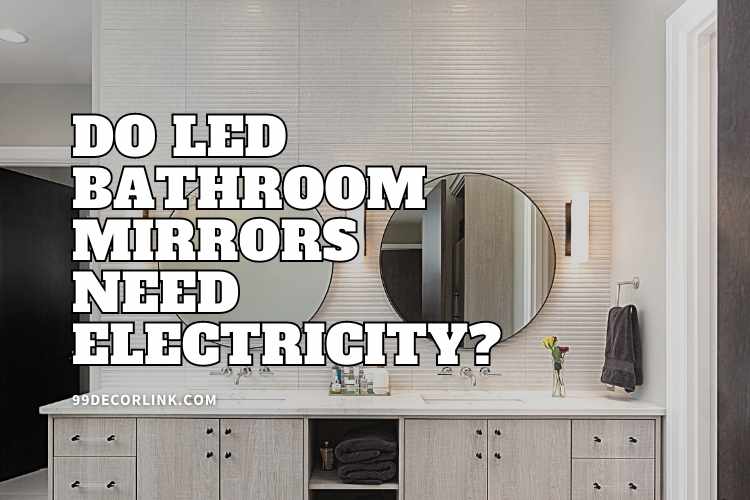Do LED Bathroom Mirrors Need Electricity?
Are you considering upgrading your bathroom mirror to a modern LED version? LED bathroom mirrors have become increasingly popular in recent years due to their sleek design and energy efficiency.
But have you ever wondered how these mirrors get their power? Unlike traditional mirrors, LED bathroom mirrors require electricity to function, adding a touch of innovation and functionality to your daily routine.
In this guide, I will explore the various methods through which LED bathroom mirrors receive their power, from hardwiring to battery operation. We will delve into the advantages and disadvantages of each power source, helping you make an informed decision when choosing the right LED bathroom mirror for your needs.
So, if you’re ready to shed some light on this electrifying topic, let’s dive in and discover how LED bathroom mirrors get their power!

Do LED Bathroom Mirrors Need Electricity?
Before we delve into how LED bathroom mirrors get their power, let’s take a moment to understand the technology behind LED lighting. LED stands for Light Emitting Diode, which is a semiconductor device that produces light when an electric current passes through it.
Unlike traditional incandescent bulbs, LED lights are more energy-efficient, durable, and have a longer lifespan. LED technology has revolutionized the lighting industry, and its benefits have extended to bathroom mirrors as well.
LED bathroom mirrors utilize LED strips or panels that are integrated into the mirror’s frame or behind the reflective surface. These LEDs emit light when powered, providing illumination for grooming tasks and creating an ambient glow in the bathroom. Now that we have a basic understanding of LED technology, let’s explore how LED bathroom mirrors are powered.
How LED Bathroom Mirrors Are Powered?
LED bathroom mirrors require a power source to operate. There are several power options available, each with its advantages and limitations. Let’s take a closer look at these power sources:
Hardwired LED Bathroom Mirrors
Hardwiring is a common method of powering LED bathroom mirrors. In this setup, the mirror is connected directly to the electrical wiring of your home. A licensed electrician would typically handle the installation, ensuring that the mirror receives a constant supply of power.
Hardwired LED bathroom mirrors offer a seamless and clean look, as there are no visible cords or plugs. This power option also eliminates the need to replace batteries or worry about charging.
One of the main advantages of hardwired LED bathroom mirrors is the reliability of a consistent power supply. You don’t have to worry about the mirror running out of power or dimming over time.
Additionally, hardwiring allows for integrated features such as built-in defoggers, touch controls, and even Bluetooth connectivity for music playback. However, the installation process can be more complex and may require professional assistance.
Battery-powered LED Bathroom Mirrors
If you prefer a more flexible and portable option, battery-powered LED bathroom mirrors might be the right choice for you. These mirrors are equipped with a built-in battery pack that provides the necessary power for the LEDs to function.
Moreover, battery-powered mirrors are easy to install and can be moved around without the need for electrical outlets. They are especially convenient for rented spaces or if you want to avoid any electrical work.
One of the main advantages of battery-powered LED bathroom mirrors is their versatility. You can place them anywhere in the bathroom, without being restricted by the proximity to electrical outlets.
Battery-powered mirrors are also a great option for bathrooms with limited electrical access. However, it’s important to consider the battery life and the need for periodic battery replacements or recharging.
Plug-in LED Bathroom Mirrors
Plug-in LED bathroom mirrors offer a middle ground between hardwired and battery-powered options. These mirrors come with a power cord that can be plugged into a nearby electrical outlet.
Plug-in mirrors provide a reliable power source, without the need for complex installations or battery replacements. They offer the convenience of a constant power supply while maintaining a clean and cord-free appearance.
One of the advantages of plug-in LED bathroom mirrors is the ease of installation. You can simply plug them into an existing electrical outlet, eliminating the need for electrical work or battery maintenance.
Plug-in mirrors also allow for additional features such as integrated lighting controls or even anti-fog capabilities. However, the positioning of the mirror may be limited by the proximity to electrical outlets.
Solar-powered LED Bathroom Mirrors
For those looking for an eco-friendly and sustainable option, solar-powered LED bathroom mirrors are worth considering. These mirrors are equipped with solar panels that convert sunlight into electrical energy, powering the LEDs.
Solar-powered mirrors are typically installed near a window or in a location that receives ample sunlight. They offer a renewable source of power and can help reduce your carbon footprint.
One of the main advantages of solar-powered LED bathroom mirrors is their energy efficiency. By harnessing the power of the sun, these mirrors can operate without relying on the electrical grid.
Solar-powered mirrors also eliminate the need for wiring or batteries, making the installation process simpler. However, it’s important to consider the availability of sunlight and the potential for reduced functionality during cloudy days or in bathrooms with limited natural light.
Factors to Consider When Choosing a Power Option for LED Bathroom Mirrors
When deciding on the power source for your LED bathroom mirror, there are several factors to consider:
1. Installation
Determine the complexity and cost of installation for each power option. If you’re comfortable with electrical work or have access to a professional electrician, hardwired mirrors may be a suitable choice. If you prefer a simple and DIY-friendly installation, battery-powered or plug-in mirrors might be more suitable.
2. Flexibility
Consider how flexible you want your mirror’s placement to be. Battery-powered mirrors offer the most flexibility as they can be moved around without any restrictions. Hardwired mirrors, on the other hand, require a fixed electrical connection.
3. Power Supply
Evaluate the reliability and convenience of each power option. Hardwired and plug-in mirrors provide a constant power supply, eliminating the need for battery replacements or recharging. Battery-powered mirrors offer portability but may require regular battery maintenance. Solar-powered mirrors are reliant on sunlight availability.
4. Additional Features
Determine if you want any additional features such as built-in defoggers, touch controls, or Bluetooth connectivity. Hardwired mirrors often offer more integrated features compared to battery-powered or plug-in options.
Consider your specific needs and preferences when making a decision. It’s also worth consulting with a professional electrician or bathroom designer to ensure that your chosen power option aligns with your bathroom’s electrical requirements and overall design.
Conclusion
LED bathroom mirrors are an excellent addition to any bathroom, providing both functionality and aesthetics. Understanding how these mirrors get their power is essential when choosing the right option for your needs. Whether you opt for a hardwired, battery-powered, plug-in, or solar-powered LED bathroom mirror, each power source offers its own advantages and limitations.
Hardwired mirrors provide a reliable power supply and a seamless look, but installation can be more complex. Battery-powered mirrors offer flexibility and easy installation, but battery maintenance is required. Plug-in mirrors provide a constant power supply without the need for complex installations. Solar-powered mirrors are eco-friendly but rely on sunlight availability.
Consider factors such as installation, flexibility, power supply, and additional features when choosing the power source for your LED bathroom mirror. By making an informed decision, you can enhance your bathroom experience with an LED mirror that suits your needs and style. So, go ahead and illuminate your bathroom with the power of LED technology!

